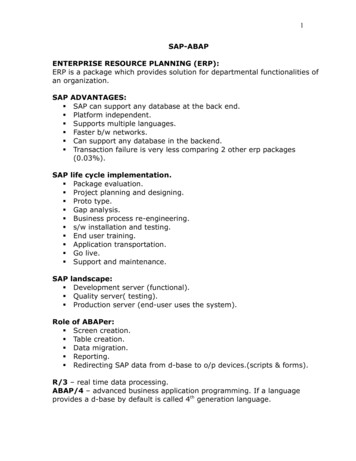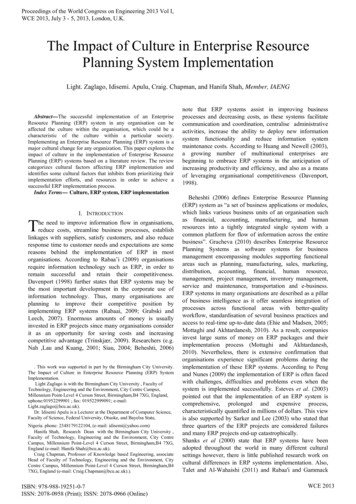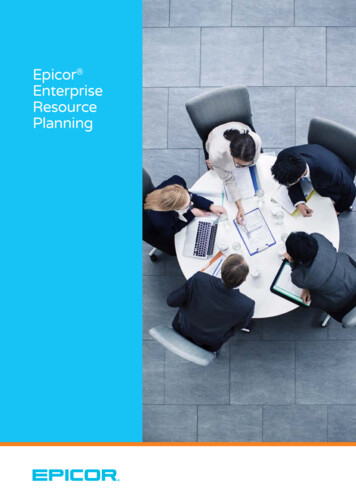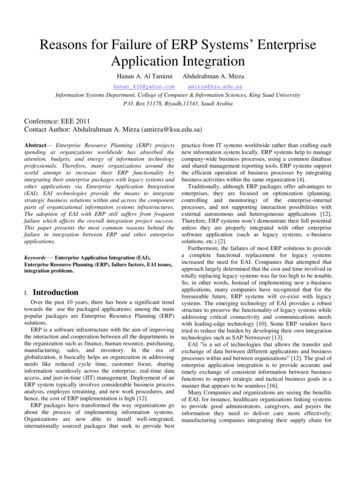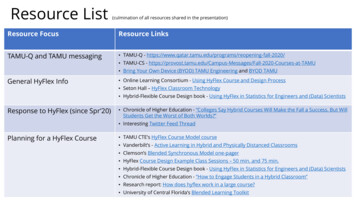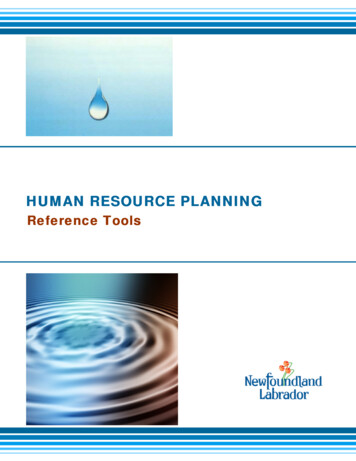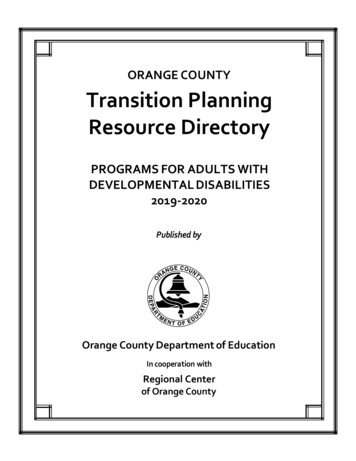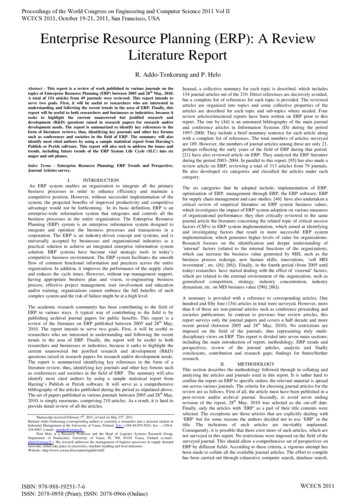
Transcription
Proceedings of the World Congress on Engineering and Computer Science 2011 Vol IIWCECS 2011, October 19-21, 2011, San Francisco, USAEnterprise Resource Planning (ERP): A ReviewLiterature ReportR. Addo-Tenkorang and P. HeloAbstract - This report is a review of work published in various journals on thetopics of Enterprise Resource Planning (ERP) between 2005 and 28th May, 2010.A total of 154 articles from 49 journals were reviewed. This report intends toserve two goals. First, it will be useful to researchers who are interested inunderstanding and following the recent trends in the area of ERP. Finally, thisreport will be useful to both researchers and businesses or industries; because itseeks to highlight the current unanswered but justified research anddevelopment (R&D) questions raised in research papers for research and/ordevelopment needs. The report is summarized to identify key references in theform of literature reviews; thus, identifying key journals and other key forumssuch as conferences and societies in the field of ERP. The summary will alsoidentify most cited authors by using a sample statistical report from Harzing’sPublish or Perish software. This report will also seek to address the issues andtrends, including future trends of the ERP System Life Cycle (SLC) into sixmajor and sub phases.Index Terms - Enterprise Resource Planning; ERP Trends and Perspective;Journal Articles survey.I.INTRODUCTIONAn ERP system enables an organization to integrate all the primarybusiness processes in order to enhance efficiency and maintain acompetitive position. However, without successful implementation of thesystem, the projected benefits of improved productivity and competitiveadvantage would not be forthcoming. In its basic definition, ERP is anenterprise-wide information system that integrates and controls all thebusiness processes in the entire organization. The Enterprise ResourcePlanning (ERP) system is an enterprise information system designed tointegrate and optimize the business processes and transactions in acorporation. The ERP is an industry-driven concept and systems, and isuniversally accepted by businesses and organizational industries as apractical solution to achieve an integrated enterprise information systemsolution. ERP systems have become vital strategic tools in today’scompetitive business environment. The ERP system facilitates the smoothflow of common functional information and practices across the entireorganization. In addition, it improves the performance of the supply chainand reduces the cycle times. However, without top management support,having appropriate business plan and vision, re-engineering businessprocess, effective project management, user involvement and educationand/or training, organizations cannot embrace the full benefits of suchcomplex system and the risk of failure might be at a high level.The academic research community has been contributing to the field ofERP in various ways. A typical way of contributing to the field is bypublishing archival journal papers for public benefits. This report is areview of the literature on ERP published between 2005 and 28th May,2010. The report intends to serve two goals. First, it will be useful toresearchers who are interested in understanding and following the recenttrends in the area of ERP. Finally, the report will be useful to bothresearchers and businesses or industries; because it seeks to highlight thecurrent unanswered but justified research and development (R&D)questions raised in research papers for research and/or development needs.The report is summarized identifying key references in the form of aliterature review; thus, identifying key journals and other key forums suchas conferences and societies in the field of ERP. The summary will alsoidentify most cited authors by using a sample statistical report fromHarzing’s Publish or Perish software. It will serve as a comprehensivebibliography of the articles published during the period as stipulated above.The set of papers published in various journals between 2005 and 28th May,2010, is simply enormous, comprising 210 articles. As a result, it is hard toprovide detail review of all the articles.Manuscript received February 5th, 2011; revised on May 23rd, 2011.Richard Addo-Tenkorang (corresponding author) is currently a researcher and a doctoral student inIndustrial Management at the University of Vaasa, Finland. Tel:- 358-40-870-5023; fax: - 358-6324-8467; e-mail:- ratenko@uwasa.fi.Petri Helo is a Research Professor and the Head of Logistics Systems Research Group,Department of Production, University of Vaasa, PL 700, 65101 Vaasa, Finland (e-mail:phelo@uwasa.fi ). His research addresses the management of logistics processes in supply demandnetworks, which take place in electronics, machine building and food industries.Website:- http://www.uwasa.fi/tuotanto/english/staff/ISBN: 978-988-19251-7-6ISSN: 2078-0958 (Print); ISSN: 2078-0966 (Online)Instead, a collective summary for each topic is described, which includes154 journal articles out of the 210. Direct references are decisively avoided,but a complete list of references for each topic is provided. The reviewedarticles are organized into topics and some collective properties of thearticles are described for each topic and sub-topics where needed. Fourreview articles/structured reports have been written on ERP prior to thisreport. The one by [44] is an annotated bibliography of the main journaland conference articles in Information Systems (IS) during the period1997–2000. They include a brief summary sentence for each article alongwith a complete list of references. The total numbers of articles surveyedare 189. However, the numbers of journal articles among these are only 21,perhaps reflecting the early years of the field of ERP during that period.[21] have also reviewed article on ERP. They analyzed the ERP literatureduring the period 2003–2004. In parallel to this report, [95] has also made areview article on ERP; reviewing a total of 313 articles from 79 journals.He also developed six categories and classified the articles under eachcategory.The six categories that he adopted include; implementation of ERP,optimization of ERP, management through ERP, the ERP software, ERPfor supply chain management and case studies. [46] have also undertaken acritical review of empirical literature on ERP system business values,which investigates the impact of ERP system adoption on various measuresof organizational performance; they then critically reviewed in the samejournal article the literature concerning the related topic of critical successfactors (CSFs) in ERP system implementation, which aimed at identifyingand investigating factors that result in more successful ERP systemimplementation, which generates higher levels of value for organizations.Research focuses on the identification and deeper understanding of‘internal’ factors (related to the internal functions of the organization),which can increase the business value generated by MIS, such as thebusiness process redesign, new human skills, innovations, ‘soft MISinvestment’, etc. ([6]; [86]). Finally, in the fourth period (from 2005 untiltoday) researches have started dealing with the effect of ‘external’ factors,which are related to the external environment of the organization, such asgeneralized competition, strategy, industry concentration, industrydynamism, etc. on MIS business value ([90]; [86]).A summary is provided with a reference to corresponding articles. Onehundred and fifty four (154) articles in total were surveyed. However, morethan 8 of these are non-journal articles such as conference proceeding andsocieties publications. In contrast to previous four review articles, thisreport surveys only the journal papers and covers a half decade and morerecent period (between 2005 and 28th May, 2010). No restrictions areimposed on the field of the journals, thus representing truly multidisciplinary views on ERP. This report is divided into seven main sections;including the main introduction of report, methodology, ERP trends andperspectives, review of the journal articles, analysis and finallyconclusions, contribution and research gaps; findings for future/furtherresearch.II.METHODOLOGYThis section describes the methodology followed through in collating andanalyzing the articles and journals used in this report. It is rather hard toconfine the report on ERP to specific orders; the relevant material is spreadout across various journals. The criteria for choosing journal articles for thereview are as follows. First of all, the article must have been published in apeer-review and/or archival journal. Secondly, to avoid never endingrevision of the report, 28th May, 2010 was selected as the cut-off date.Finally, only the articles with ‘ERP’ as a part of their title contents wereselected. The exceptions are those articles that are explicitly dealing with‘ERP’ but for some reasons the authors decided not to use ‘ERP’ in thetitle. The inclusions of such articles are inevitably unplanned.Consequently, it is possible that there exist more of such articles, which arenot surveyed in this report. No restrictions were imposed on the field of thesurveyed journal. This should allow a comprehensive set of perspectives onERP by different fields. According to these criteria, a vigorous attempt hasbeen made to collate all the available journal articles. The effort to compilehas been carried out through exhaustive computer search, database search,WCECS 2011
Proceedings of the World Congress on Engineering and Computer Science 2011 Vol IIWCECS 2011, October 19-21, 2011, San Francisco, USAinternet search, reference checking, most cited authors using Harzing’sPublish or Perish software, etc. However, it is always possible that some ofthe articles are missing from this list. A Harzing’s Publish or Perishsoftware statistical results for mostly cited authors in the field of ERPbetween 2005 and 2010 is found in Tables I, II, and III below in adescending-order.TABLE IHARZING’S PUBLISH OR PERISH MOST CITED ERP JOURNAL ARTICLES AND AUTHORS*Harzing's Publish or Perish - General Citation Search for "Enterprise Resource Planning" -&- "ERP" (2005-2010) Title words 4[2]18[102]17[88]15[127]9TitleIdentifying critical issues in enterpriseresource planning (ERP) implementationEnterprise resource planning (ERP): areview of the literatureAchievement assessment for enterpriseresource planning (ERP) systemimplementations based on critical successfactors (CSFs)Enterprise resource planning (ERP)--Abrief historyManaging user acceptance towardsenterprise resource planning (ERP)systems-understanding the dissonancebetween user expectations and managerialpoliciesEnterprise resource planning (ERP)implementation: a useful road mapYear2005SourceComputers in IndustryPublisherElsevier2007International Journal ofManagement and EnterpriseInternational Journal of Production Inderscience2007Journal of Operations ManagementElsevier2005European Journal of Information ingentaconnect.com2006 of Management and EnterpriseInderscienceEnterprise resource planning (ERP)operations support system for maintainingprocess integrationA conceptual model for enterpriseresource planning (ERP)2005International Journal of ProductionResearchinformaworld.com2005Information Management & emeraldinsight.com2005ElsevierIdentification of critical failure factors in2005 of Management and EnterpriseIndersciencethe implementation of enterprise resource planning (ERP) system in Taiwan'sindustries[61]Do top-and mid-level managers view2006 Journal of Management andInderscienceEnterprise Resource Planning (ERP)Enterprise systems success measures differently?*Harzing’s Publish or Perish Most Cited Authors (Accessed on 28/05/2010, Revised on 07/07/2010).*The Harzing’s Publish or Perish software used for general citation search for “Enterprise Resource Planning” in All the words field and“ERP” in Any of the words field and then Title words only box ticked.TABLE IIHARZING’S PUBLISH OR PERISH MOST CITED ERP JOURNAL ARTICLES AND AUTHORS*Harzing's Pulish or Perish - General Citation Search for "Enterprise Resource Planning" (2005-2010) Title words only.Cites69Authors[35]TitleEnterprise resource planning systems,management control and the quest forintegrationIdentifying critical issues in enterpriseresource planning (ERP) implementationYear2005SourceAccounting, Organizations andSocietyPublisherElsevier62[41]2005Computers in IndustryElsevier42[95]Enterprise resource planning (ERP): areview of the literature2007International Journal ofManagement and EnterpriseInderscience42[91]2005Industrial Management & Data emeraldinsight.com37[124]2005International Journal of Production ournal of Operations 4]Enterprise resource planning andorganisational innovation: a managementperspectiveAchievement assessment for enterpriseresource planning (ERP) systemimplementations based on critical successfactors (CSFs)Enterprise resource planning systems andits implications for operations functionEnterprise resource planning (ERP)--Abrief historyImplementation of enterprise resourceplanning in ChinaManaging user acceptance towardsenterprise resource planning (ERP)systems-understanding the dissonancebetween user expectations and managerialpolicies2005European Journal of Information ingentaconnect.com24[8]2007The Journal of High Technology Elsevier24[2]2006[37] of Management and Enterprise International Journal of ProductionResearchInderscience21Organizational adoption of enterpriseresource planning systems: A conceptualframeworkEnterprise resource planning (ERP)implementation: a useful road mapStrategic success factors in enterpriseresource-planning design andimplementation: a case-study approach21[109]Enterprise resource planning systems,strategic ent
ERP systems have become vital strategic tools in today’s competitive business environment. The ERP system facilitates the smooth flow of common functional information and practices across the entire organization. In addition, it improves the performance of the supply chain and reduces the cycle times. However, without top management support, having appropriate business plan and vision, re .

